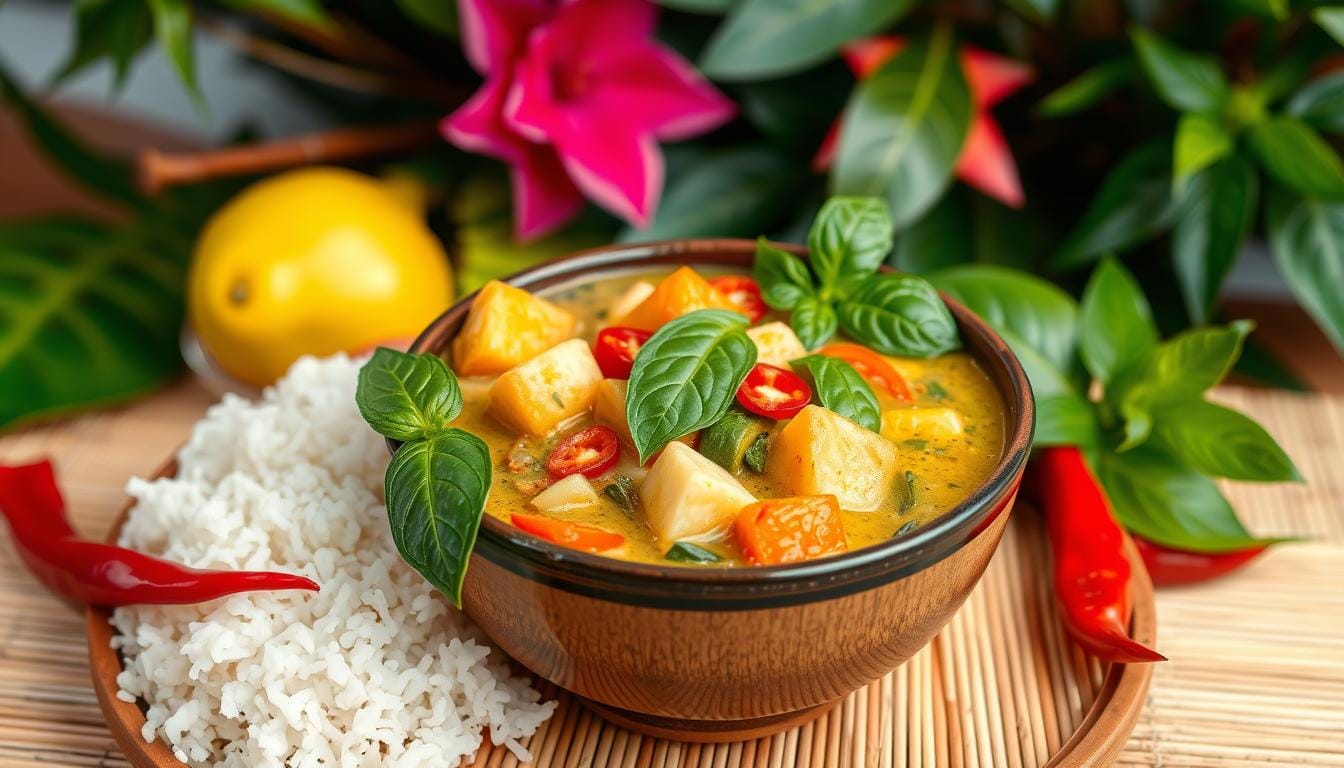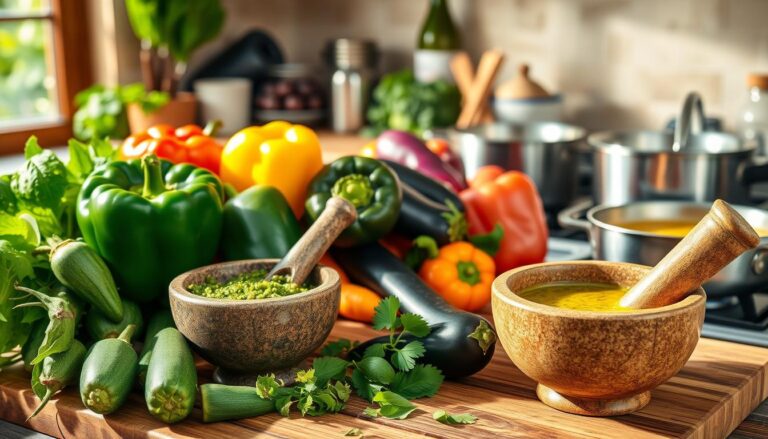Best Thai Green Curry with Vegetables: A Creamy and Spicy Dish
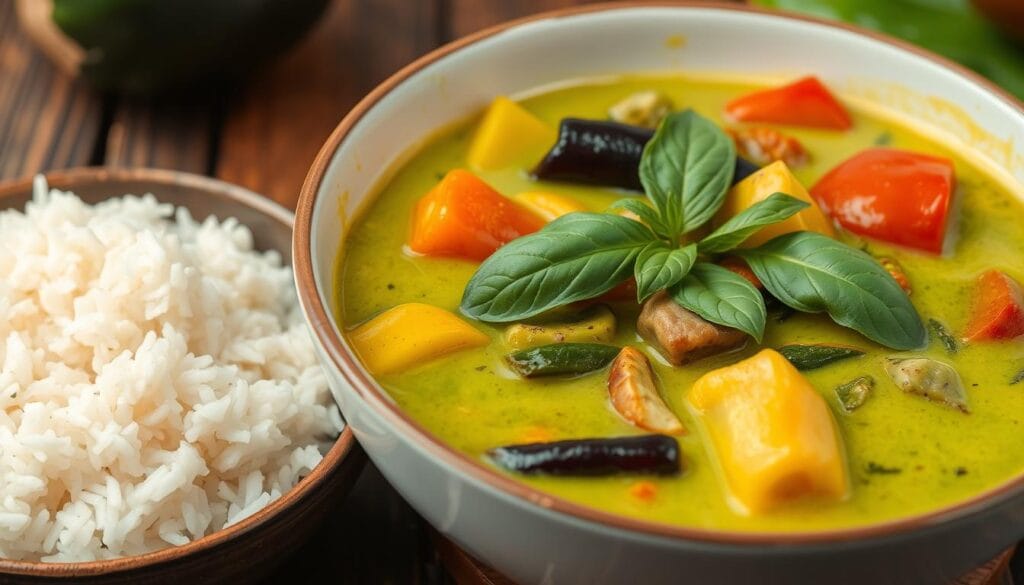
Table of Contents
Best Thai Green Curry with Vegetables: A Creamy and Spicy Dish
The first time I tasted Thai Green Curry, it was a game-changer. The creamy coconut milk mixed with spices was like a flavor bomb. It took me straight to Bangkok’s lively streets.
Thai Green Curry is more than food; it’s a healthy taste adventure. Every bite offers a mix of flavors that feeds both your body and soul. It’s great for anyone looking for tasty, nutritious meals.
This dish is not just about filling your belly. It’s about enjoying a mix of fresh veggies, herbs, and spices. Making Thai Green Curry at home connects you to Thailand’s food traditions.
Whether you’re an experienced cook or just starting out, this recipe will open your eyes to new flavors. It’s a journey to healthier eating that will excite your taste buds and nourish your body.
Introduction to Authentic Thai Green Curry
Thai green curry is a vibrant journey through Southeast Asian cuisine. It mixes complex flavors, aromatic herbs, and rich ingredients. These elements turn simple meals into unforgettable experiences.
Origins and Cultural Significance
Green curry comes from central Thailand and is a key part of traditional cooking. Chefs use fresh local ingredients to create a mix of spicy, sweet, and savory tastes. The green color comes from green chilies and herbs ground into a paste.
- Developed in the royal Thai cuisine
- Represents culinary creativity of Thai chefs
- Reflects regional agricultural traditions
Health Benefits of Thai Curry
Thai green curry is packed with nutritional benefits. Coconut milk and fresh veggies add essential nutrients. Ingredients like lemongrass, ginger, and green chilies have antioxidants and anti-inflammatory properties.
“A single bowl of Thai green curry can transform your understanding of nutrition and flavor.” – Thai Culinary Expert
Why Make Green Curry at Home
Making thai green curry at home lets you control the ingredients and flavor. You can adjust it to your taste, try different veggies, and use the best, freshest ingredients. Coconut milk makes the dish creamy and enhances the flavor.
- Control ingredient quality
- Adjust spice levels
- Explore culinary creativity
- Save money compared to restaurant dining
Essential Ingredients for Thai Green Curry
Making a real Thai green curry needs fresh, lively ingredients. These ingredients mix to create a dish full of complex tastes. The heart of this curry is its special blend of herbs and spices.
- Thai Chilies: These peppers add the heat to the curry. Fresh green thai chilies give a sharp, intense spiciness.
- Galangal: This root tastes like ginger but is more robust and citrusy. It adds depth and complexity to the curry paste.
- Lemongrass: This herb adds a bright, citrusy flavor. It’s usually bruised or chopped to release its oils and aroma.
Choose fresh ingredients for the best taste. Local Asian markets or specialty stores have these authentic items. If you can’t find them, some substitutes can work, but they’ll change the flavor a bit.
“The secret to an exceptional Thai green curry is in the quality of your ingredients” – Traditional Thai Chef
The success of your green curry depends on these key elements. Fresh thai chilies add heat, galangal brings complexity, and lemongrass adds a bright, citrusy flavor. Together, they make the dish unforgettable.
Making the Perfect Green Curry Paste from Scratch
Making green curry paste is like creating a work of art. It turns simple ingredients into a vibrant dish. The paste is the heart of Thai green curry, blending flavors and aromas.
To make green curry paste, you need precision and traditional skills. Key ingredients include kaffir lime leaves, fish sauce, and shrimp paste. These add depth and complexity to your curry.
Traditional vs Modern Preparation Methods
Thai cooks often use a mortar and pestle to make curry paste. This method extracts more flavors. Modern food processors are quicker but might lose some of these flavors.
- Traditional method: Pound ingredients manually in a stone mortar
- Modern method: Blend ingredients in a food processor
- Recommended technique: Combine both methods for optimal results
Storage and Shelf Life
Proper storage keeps your green curry paste fresh. It’s important to keep the balance of ingredients like kaffir lime leaves and shrimp paste.
- Refrigerate in an airtight container
- Use within 1-2 weeks for maximum freshness
- Freeze for extended preservation up to 3 months
Common Mistakes to Avoid
When making green curry paste, avoid common mistakes. Don’t over-process, use stale spices, or ignore the balance of fish sauce and aromatics.
“The secret to an exceptional green curry paste lies in the quality of your ingredients and the care in preparation.” – Traditional Thai Chef
Mastering these techniques will help you make a green curry paste that’s true to Thai cuisine. You’ll enjoy restaurant-quality flavors in your own kitchen.
Selecting and Preparing Fresh Vegetables
Making a tasty Thai green curry begins with picking the right veggies. Fresh ingredients are essential for a healthy meal and to enhance your cooking. The right veggies can turn a simple curry into a nutritious and flavorful feast.
- Bamboo shoots (a traditional and authentic ingredient)
- Bell peppers
- Eggplant
- Zucchini
- Green beans
Bamboo shoots are a standout in Thai dishes. These tender, slightly crunchy vegetables bring a special texture and mild taste to your curry. They’re low in calories and full of nutrients, making them great for a healthy meal.
Getting your veggies ready is key to keeping them fresh:
- Wash all vegetables thoroughly
- Cut into uniform bite-sized pieces
- Remove any tough stems or seeds
- Keep vegetables crisp by avoiding overcooking
“Fresh vegetables are the heart of an authentic Thai green curry” – Chef Somchai
Pro tip: Pick veggies that cook at the same rate. Harder veggies like bamboo shoots and carrots need more time. Softer ones like zucchini cook faster.
The Role of Coconut Milk in Thai Curries
Coconut milk is key in making real Thai curries. It turns simple dishes into creamy, rich meals. If you love healthy eating and trying new foods, knowing about coconut milk can make you a better cook.
Selecting Premium Coconut Milk
Not all coconut milk is the same. When picking coconut milk for your curry, look for these things:
- Fat content (higher fat means richer flavor)
- Minimal additives
- Organic and sustainably sourced options
- Thickness and consistency
Mastering Curry Consistency
To get the right curry texture, you need skill. Gently simmer your coconut milk to keep it smooth. Stir now and then and adjust the heat to make a sauce that covers your veggies well.
Health Benefits of Coconut Milk
Coconut milk tastes great and is good for you too. It’s a dairy-free choice full of good fats and nutrients. For those who can’t eat dairy or want plant-based meals, coconut milk is a great pick.
“Coconut milk isn’t just an ingredient; it’s a gateway to exploring vibrant, nutritious cuisine.” – Chef Maria Rodriguez
Step-by-Step Cooking Instructions
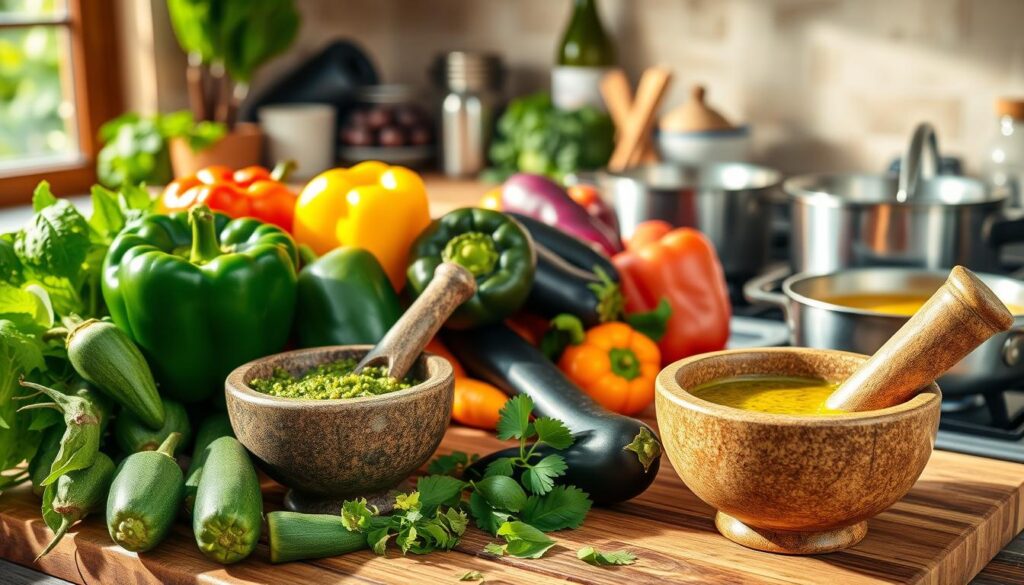
Making a real Thai Green Curry needs care and love. This guide will show you how to turn simple items into a tasty dish.
- Prepare Your Ingredients
- Chop vegetables evenly
- Measure curry paste
- Open coconut milk can
- Build the Flavor Base
- Heat oil in a big wok or deep skillet
- Sauté Thai Green Curry paste for 2-3 minutes
- Let aromatic oils release and flavors deepen
- Create the Curry Sauce
- Pour in coconut milk
- Stir until paste is fully mixed
- Simmer on medium heat
- Add Vegetables and Protein
- Start with harder vegetables first
- Add protein like chicken or tofu
- Cook until vegetables are tender-crisp
“The secret to a perfect Thai Green Curry lies in balancing flavors and cooking with intention.” – Bangkok Street Chef
Professional chefs say to taste and adjust seasonings as you go. A little sugar or fish sauce can make your Thai Green Curry amazing.
Keep the heat steady and stir now and then to avoid burning. Aim for a creamy, vibrant curry that truly captures the spirit of Thai cooking.
Aromatics and Herbs: Balancing Flavors
Making a real Thai green curry is all about balancing aromatics and herbs. It turns a simple dish into a work of art. Each ingredient adds to the dish’s complex taste.
Kaffir Lime Leaves: The Citrusy Essence
Kaffir lime leaves are a must in Thai cooking. They add a strong citrusy smell that’s hard to find elsewhere. Here are some tips for using them in your curry:
- Tear the kaffir lime leaves slightly to release their essential oils
- Add them early in the cooking process for maximum flavor infusion
- Remove whole leaves before serving for a smooth dining experience
Thai Basil: A Fresh Herbal Touch
Thai basil gives your curry a fresh taste that’s unique. It’s different from sweet basil, with a spicy and anise-like flavor. This flavor pairs well with the rich coconut milk.
Lemongrass: The Aromatic Backbone
Lemongrass is key in Thai dishes, adding a bright citrusy taste with a hint of wood. Here’s how to get the most out of it:
- Bruise the lemongrass stalk to release its aromatic compounds
- Chop finely or use whole stalks depending on your recipe
- Remove tough outer layers before using
“The magic of Thai cuisine lies in its ability to balance complex flavors through carefully selected herbs and aromatics.” – Thai Culinary Expert
Mastering kaffir lime leaves, basil, and lemongrass will make your green curry amazing. It will truly capture the spirit of Thai cooking.
Serving Suggestions and Accompaniments
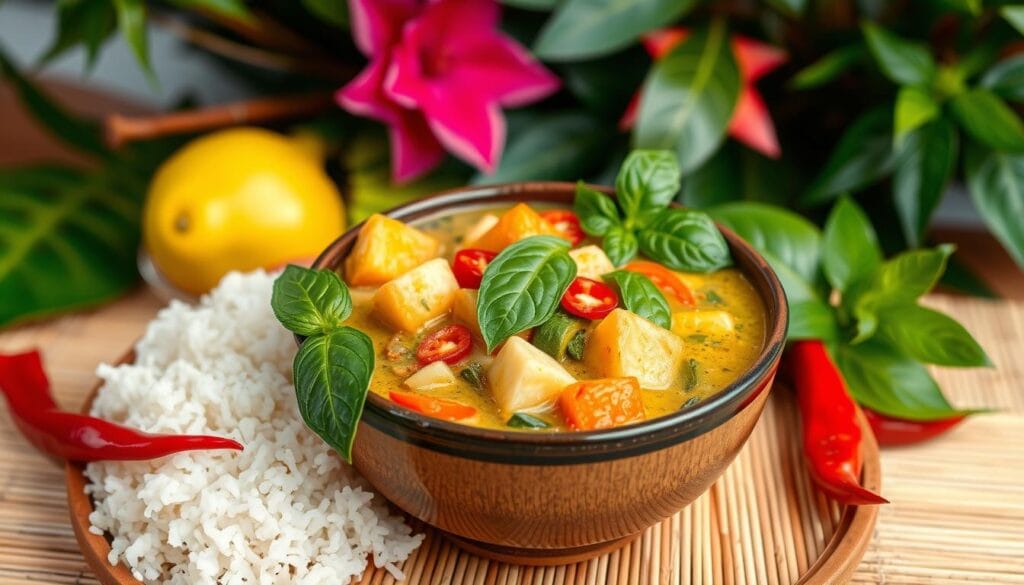
Creating the perfect Thai Green Curry is more than just the main dish. Thoughtful accompaniments can enhance your experience. They add to the rich, spicy flavors and support healthy eating.
Here are some tasty and healthy options to serve with your Thai Green Curry:
- Jasmine Rice: The traditional and most classic pairing
- Cauliflower Rice: A low-carb alternative for health-conscious diners
- Zucchini Noodles: A light and fresh complement to the curry
- Brown Rice: A whole grain option packed with nutrients
Choosing the right drinks can make your Thai Green Curry meal even better. Try coconut water or a crisp white wine. They balance the curry’s intense flavors nicely.
| Accompaniment | Nutritional Benefit | Flavor Compatibility |
|---|---|---|
| Jasmine Rice | Moderate carbohydrates | Perfect flavor absorption |
| Cauliflower Rice | Low-carb, high fiber | Neutral base |
| Steamed Vegetables | High in vitamins | Adds texture |
“The right accompaniment can transform a good Thai Green Curry into an extraordinary meal.” – Chef Mai Pham
Your Thai Green Curry can be a versatile, healthy dish. Try different sides to find the perfect match for your taste and diet.
Conclusion
Making Thai Green Curry at home is more than cooking. It’s a journey into vibrant flavors and healthy eating. It’s a way to enjoy Southeast Asian traditions while eating well.
This guide has taught you how to make a dish as good as a restaurant’s. You’ve learned about fresh veggies and balancing spices. Each step helps you understand Thai cooking better. Remember, practice and passion are essential to get it right.
Keep trying new things with Thai Green Curry. Each time, you can show off your cooking skills and creativity. Whether you’re experienced or just starting, this recipe is a great way to explore new flavors and eat well.
Enjoy the process, trust your taste, and relish every bite of your homemade Thai Green Curry.
FAQ
What makes Thai green curry different from other curry types?
Thai green curry stands out with its bright green color from fresh chilies and herbs. It has a delicate, slightly sweet taste. This is thanks to coconut milk and herbs like lemongrass and kaffir lime leaves.
Is Thai green curry spicy?
Yes, Thai green curry is quite spicy. You can adjust the heat by changing the amount of Thai chilies. If you prefer less spice, use fewer chilies or green peppers.
Where can I find authentic ingredients for Thai green curry?
Look for galangal, kaffir lime leaves, and shrimp paste at Asian grocery stores or international markets. Online retailers also offer these ingredients if local stores don’t have them.
Can I make Thai green curry vegetarian or vegan?
Yes, you can make it vegetarian or vegan. Use soy sauce or vegan fish sauce instead of fish sauce. Add tofu, tempeh, or bamboo shoots and vegetables for protein.
How long can I store homemade green curry paste?
Homemade green curry paste lasts 1-2 weeks in the fridge. Freeze it in small portions for up to 3 months. This way, you always have it ready for your next curry.
What are the health benefits of Thai green curry?
Thai green curry is full of health benefits. It has anti-inflammatory herbs like lemongrass and galangal. Coconut milk adds healthy fats. The veggies provide essential nutrients, making it a nutritious meal.
Can I adjust the curry’s consistency?
Yes, you can change the curry’s consistency. Add coconut milk or water if it’s too thick. Simmer it longer or add cornstarch if it’s too thin. Aim for your preferred texture while keeping the flavor authentic.

